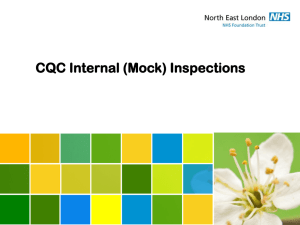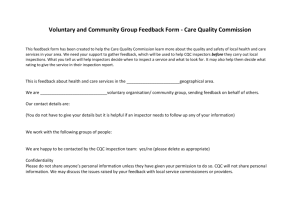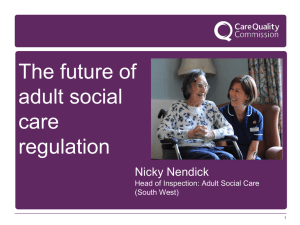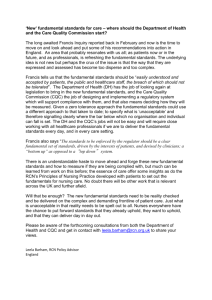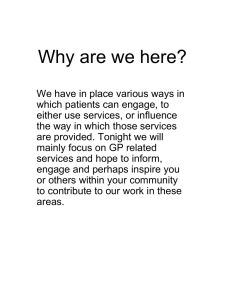Trust Board Meeting: Wednesday 8 July 2015 TB2015. 97
advertisement
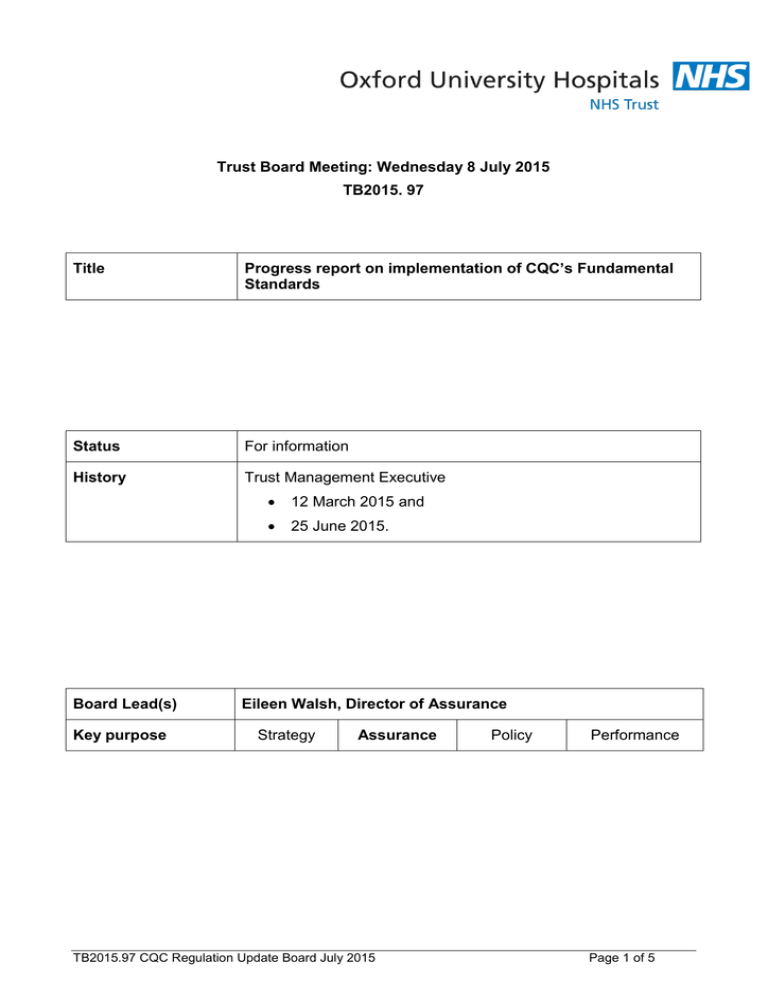
Trust Board Meeting: Wednesday 8 July 2015 TB2015. 97 Title Progress report on implementation of CQC’s Fundamental Standards Status For information History Trust Management Executive Board Lead(s) Key purpose 12 March 2015 and 25 June 2015. Eileen Walsh, Director of Assurance Strategy Assurance TB2015.97 CQC Regulation Update Board July 2015 Policy Performance Page 1 of 5 Oxford University Hospitals TB2015. 97 Executive Summary 1. This is a progress report on the implementation of the CQC’s Fundamental Standards, within the Trust’s system for assessing compliance with CQC regulations. 2. The trust system, CQCAssure, has been set against the new regulatory framework and work is underway to migrate relevant self-assessment results from the existing system across to the new system. 3. Relevant leads have been identified within the Divisions to support the completion of self-assessments and are specifically being asked to co-ordinate this review for completion by 31 July 2015. Recommendation 4. The Board is asked to: Note the progress made with migrating relevant narrative across to the new regulatory framework. TB2015.97 CQC Regulation Update Board July 2015 Page 2 of 5 Oxford University Hospitals TB2015. 97 Progress report on implementation of CQC’s Fundamental Standards 1. Introduction & Background 1.1. The purpose of this paper is to provide an update on the progress being made with the implementation of CQC’s Fundamental Standards. 1.2. From 1 April 2015 the new care regulations laid down in the Health and Social Care Act 2008 (Regulated Activities) Regulations 2014 came into force. 1.3. These regulations introduced the new ‘Fundamental Standards’ which describe requirements that reflect the recommendations made by Sir Robert Francis following his inquiry into care at Mid Staffordshire NHS Foundation Trust. 1.4. The Assurance Directorate have reviewed the new regulations and mapped the previous outcomes to the new standards as per the table below: New regulations Previous outcomes/regulations Regulation 5: Fit and proper persons: directors N/A – This is a new regulation Regulation 9: Person-centred care Outcome 1: Respecting and involving people who use services Regulation 10: Dignity and respect Outcome 1: Respecting and involving people who use services Regulation 11: Need for consent Outcome 2: Consent to care and treatment Regulation 12: Safe care and treatment Outcome 4: Care and welfare of people who use services Outcome 8: Cleanliness and infection control Outcome 9: Management of medicines Outcome 6: Cooperating with other providers Outcome 21: Records Regulation 13: Safeguarding service users from abuse and improper treatment Outcome 7: Safeguarding people who use services from abuse Regulation 14: Meeting nutritional and hydration needs Outcome 5: Meeting nutritional needs Regulation 15: Premises and equipment Outcome 10: Safety and suitability of premises Outcome 11: Safety, availability and suitability of equipment Regulation 16: Receiving and acting on complaints Outcome 17: Complaints Regulation 17: Good Governance Outcome 16: Assessing and monitoring the quality of service provision Regulation 18: Staffing Outcome 13: Staffing Outcome 14: Supporting workers Regulation 19: Fit and proper persons employed Outcome 12: Requirements relating to workers Regulation 20: Duty of candour N/A – This is a new regulation 1.5. The CQC have linked each of the new regulations to a key question, which forms the basis of their inspection methodology. These key questions are : Are services safe? Are services effective? Are services caring? Are services responsive to people’s needs? TB2015.97 CQC Regulation Update Board July 2015 Page 3 of 5 Oxford University Hospitals 2. TB2015. 97 Are services well-led? Migration of Information within CQCAssure 2.1. The system that the Trust uses as a repository for the self-assessment of compliance with the CQC’s regulations is provided by Allocate Software within the specific CQCAssure application (the system). 2.2. The current assessment of compliance takes the form of a: Narrative describing the key processes in relation to the questions the CQC posed in relation to the original essential standards / outcomes. Supporting evidence. Rating of each of those questions. 2.3. Development work has been undertaken to ensure the regulatory framework is represented within the system is in accordance with the Trust’s specifications. 2.4. In line with the mapping exercise undertaken the existing narrative in the system is being transferred from the previous outcomes to the CQC’s new Key Line of Enquiry questions. As at 23 June 2015 the transfer of the narrative responses was 70% complete. 2.5. Relevant Trust-level information which has been submitted as part of the recent Monitor and the CQC requests will be uploaded to the system so that a pool of information is available at all times. 2.6. In preparation for the new system, the Executive Directors have taken Executive Lead for new regulations. As displayed below: Regulation 9: Person-centred Care Regulation 10: Dignity and Respect Regulation 11: Need for Consent Regulation 12: Safe care and Treatment Regulation 13: Safeguarding patients/users from abuse and improper treatment Regulation 14: Meeting nutritional and hydration needs Regulation 15: Premises and equipment Regulation 16: Receiving and acting on complaints Regulation 17: Good governance Regulation 18: Staffing Regulation 19: Fit and Proper Persons Employed Regulation 20: Duty of Candour 3. Chief Nurse Chief Nurse Medical Director Medical Director Chief Nurse Chief Nurse Director of Development and the Estate Chief Nurse Medical Director Director of Workforce Director of Workforce Medical Director Next steps 3.1. Relevant leads have been identified within the Divisions to support the completion of self-assessments. These leads are specifically being asked to co-ordinate the following: Check that the narrative as moved is valid for each of the questions, Edit the narrative, as required, Complete the narrative for any new questions. Complete the rating for each of the Key Line of Enquiry questions using CQC’s criteria of Outstanding, Good, Requires Improvement or Inadequate. TB2015.97 CQC Regulation Update Board July 2015 Page 4 of 5 Oxford University Hospitals TB2015. 97 3.2. The timeline for completion is 31st July 2015. Alongside this there will be a requirement for linking of relevant evidence to the narrative with the aim of using the reporting function within the system as part of the Q2 performance review meetings. From this the reporting function will be extended to the Board and subcommittees. 3.3. Training is being made available on the new system as well as support by the Assurance Directorate to identify what makes good evidence. 3.4. Work is underway with Allocate to establish a more integrated dashboard system that will display a risk register dashboard, the overview of ratings within CQCAssure and the safe staffing information. 3.5. The peer review programme is being developed in alignment with the new Fundamental Standards. To ensure that the results of the peer review process adds to the evidence within the CQCAssure system. 4. Recommendation 4.1. The Board is asked to note the progress made with migrating relevant narrative across to the new regulatory framework. Clare Winch Deputy Director of Assurance July 2015 Report prepared by: Lucy Parsons Accreditation and Regulation Manager TB2015.97 CQC Regulation Update Board July 2015 Page 5 of 5
